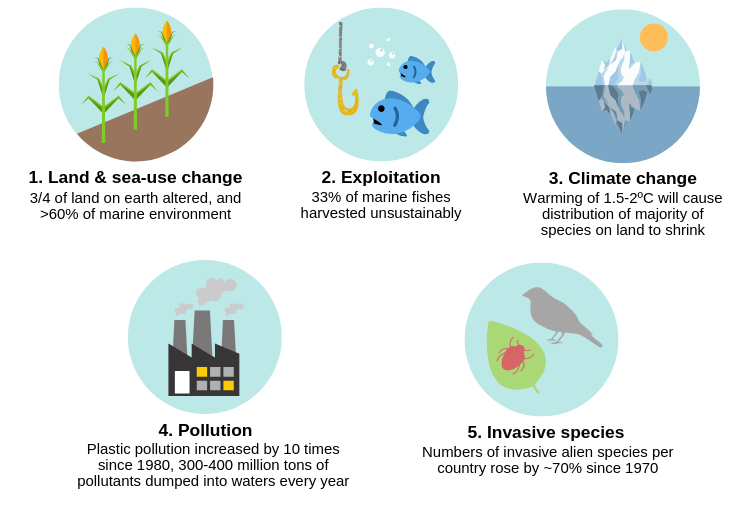One million species of plants and animals on Earth are threatened with extinction because of humans, the United Nations said in its latest grim assessment on May 6, 2019.
Scientists have described the report as the most comprehensive assessment of the global loss of nature taking place right now.
Rate of extinctions accelerating
The landmark report is by the Intergovernmental Science-Policy Platform on Biodiversity and Ecosystem Services (IPBES), a UN committee.
It details the grave impacts of human activity on the environment and its living organisms.
Compiled by 145 expert authors from 50 countries, with input from another 310 contributing authors, the report has been three years in the making.
According to the 39-page summary of the report, species loss is currently accelerating at an unprecedented pace -- 10 to 100 times higher than the average over the last 10 million years.
Some of the most notable statistics about the proportion of species currently at risk of extinction include:
- 1 million of the estimated total of 8 million species on Earth, many to be extinct within decades, which consists of:
- 1/4 of species across all terrestrial, freshwater (rivers and lakes) and marine habitats
- More than 1/3 of marine mammal
- More than 1/3 of reef-forming corals
- More than 40 percent of amphibian species
- 10 percent of insect species
Humans at fault
With the previous findings of the Intergovernmental Panel of Climate Change (IPCC) report still lingering from six months earlier -- which details the world's 12-year deadline to buck up sustainability efforts before the impacts of climate change are irreversible -- the IPBES report seems to sound the death knell for Earth and its creatures.
The blame is placed solely on humans, with land and sea-use change, exploitation, climate change, pollution and invasive species cited as the top five anthropogenic (human-caused) drivers of species extinctions, in decreasing order of impact.
Invasive species are species introduced from other locations that poses a threat to the new environment, possibly by competing for food and other resources with native wildlife.
Here's a nifty little graphic that accurately summarises the five main causes and its implications.
 Photo by Ashley Tan, information from un.org
Photo by Ashley Tan, information from un.org
Food production is one industry driving the large change in environments.
More than a third of the world's land surface is devoted to agriculture, and 75 percent of freshwater resources used for crop or livestock production.
Additionally, pollution entering coastal areas has created more than 400 dead zones in the ocean, areas devoid of marine life due to the lack of oxygen.
Human and nature are codependent
The report also emphasises humanity's dependence on the natural environment.
Pesticides used by farmers to eliminate pest insects could negatively impact bees and other pollinators, implicating not just the reproduction of wild plants, but commercial crops as well.
IPBES Chair, Sir Robert Watson reiterated the importance of nature: “We are eroding the very foundations of our economies, livelihoods, food security, health and quality of life worldwide.”
Potentially the sixth mass extinction
Species loss at such an unparalleled scale could signal the coming of Earth's sixth mass extinction, scientists say.
The ongoing event has also been dubbed the Holocene extinction (the Holocene is the geological time period that man occupies).
The previous mass extinction was 65 million years ago, when an asteroid hit Earth and wiped out the dinosaurs, resulting in a loss of 76 percent of species at that time.
This in turn made way for mammals to diversify and spread across the planet
However, this sixth mass extinction is different from the previous five extinctions, which were the result of natural processes.
Humanity's unceasing destruction of the planet now could leave no time and capacity for biodiversity and the environment to recuperate and bounce back.
Patricia Miloslavich, a contributor to the IPBES report and senior professor in the Department of Environmental Studies at Universidad Simón Bolívar, told CBS News: "It's true there have been extinctions in the past, that nature has taken its course, it's just that these have been processes that have taken millions of years and nature has had the time to adapt and provide a response."
"We are not giving nature a time to provide a response."
A call to arms
Although the report might spell doom and gloom for the environment, the authors of the IPBES report hope that the findings could serve as am impetus for stakeholders worldwide to take action.
They cited the need for a "system-wide reorganisation", and recommended several ways to take sustainability efforts up a notch.
Some suggestions include reducing food waste and revamping business supply chains, safeguarding against climate change, implementing effective fishing quotas, designating marine protected areas (MPAs) and reducing run-off pollution into the waters.
All this requires cooperation between governments, businesses and people
Despite the headlining statistic of the one million species at risk, the report has urged authorities not to ignore the threat of climate change in favour of saving biodiversity.
Both problems are correlated and the worsening of one could exacerbate the other.
Watson said: "The report also tells us that it is not too late to make a difference, but only if we start now at every level from local to global."
Top photo from U.S. Fish and Wildlife Headquarters Service, Flickr
If you like what you read, follow us on Facebook, Instagram, Twitter and Telegram to get the latest updates.
